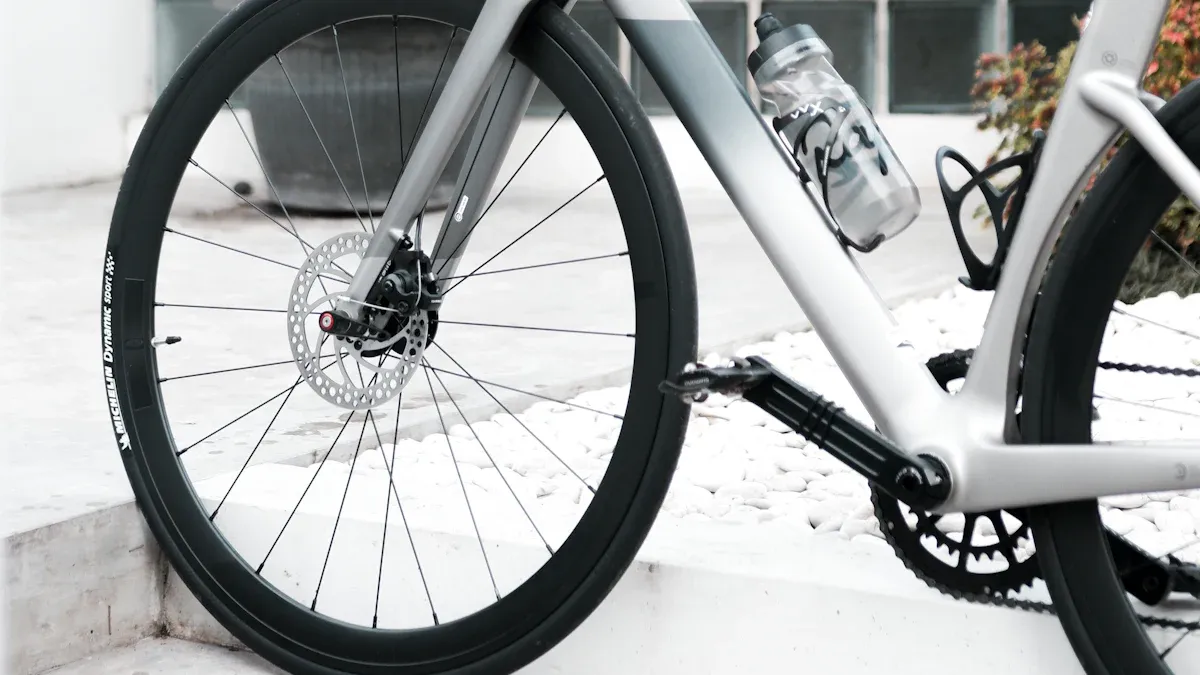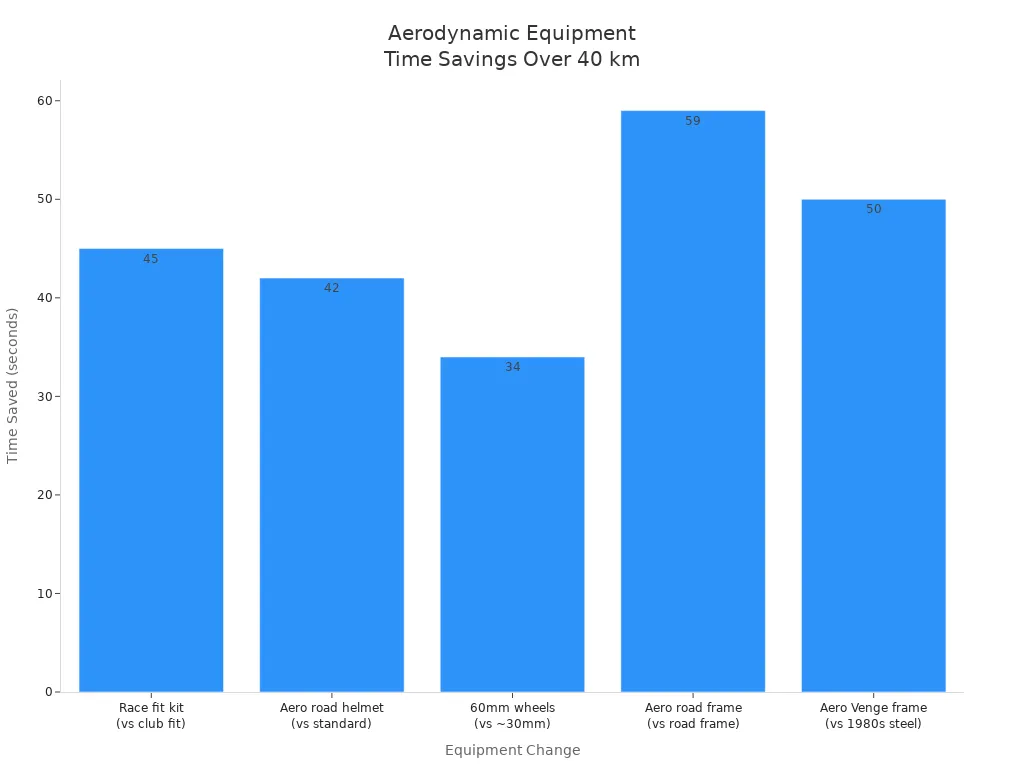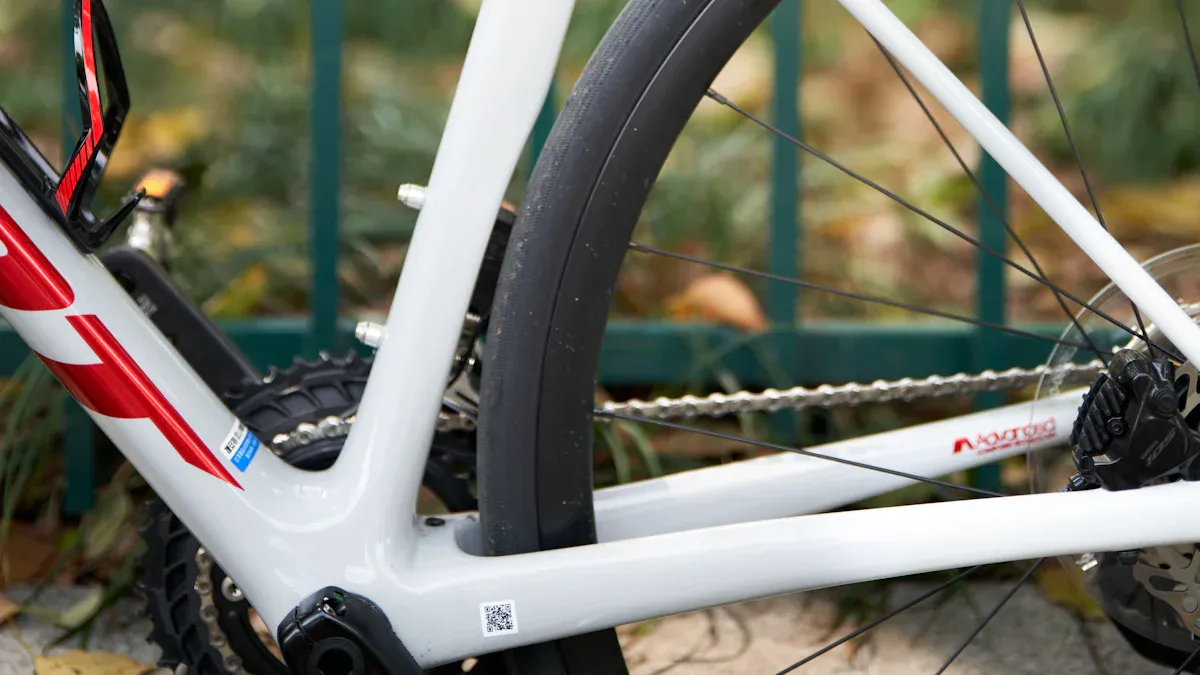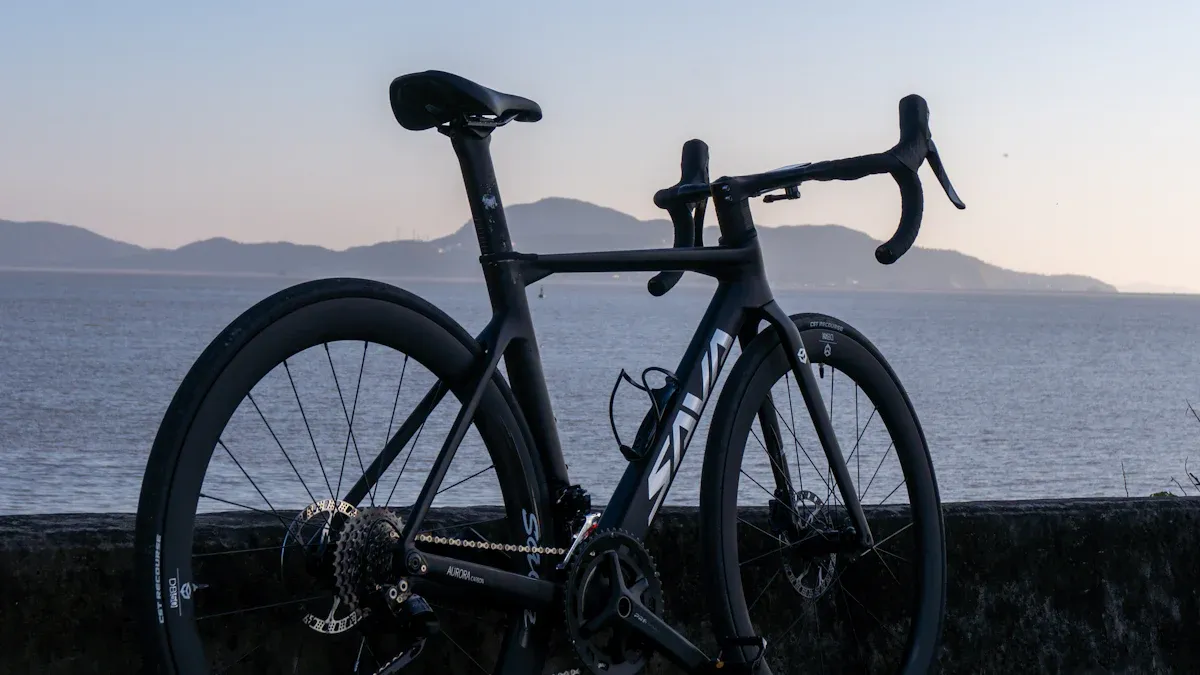
Aerodynamic bike frames have deep tubes and hidden cables. These things help cut down air resistance. Riders say these frames feel quicker on flat roads. They also feel faster on rolling hills. Experts say aero bikes have special handlebars. They also have a lower riding position. This helps riders go faster but still stay comfortable. The table below shows how aero frames save about 59 seconds over 40 km. This is compared to regular frames. A good fit and a steady posture help riders get the most from aero bikes.
Change in Equipment | Time Saved Over 40 km (seconds) |
|---|---|
Race fit kit (vs club fit kit) | 45 |
Aero road helmet (vs standard) | 42 |
60mm wheels (vs ~30mm wheels) | 34 |
Aero road frame (vs road frame) | 59 |

Key Takeaways
Aerodynamic bike frames have special tube shapes. They hide cables and use built-in parts. These things help cut wind resistance. Riders can go faster, mostly on flat or rolling roads.
Aero bikes make you ride in a low position. This lowers wind drag. It can feel less comfortable. A good bike fit helps you stay fast and comfy.
New aero bikes use light materials. They have smart designs. These things help you go faster. They also try to keep you comfortable during races and fast rides.
Aero bikes are often heavier and cost more than regular bikes. Riders should think about how they ride. They should also think about the roads they use and their budget before picking a bike.
Riders can get better aerodynamics without a new bike. They can change how they sit. They can wear tight clothes. They can use aero gear like helmets and wheels.
Aerodynamic Bike Frame Features

Tube Shapes
Aerodynamic bike frames have special tube shapes to fight wind. Standard frames use thin, round tubes. Aero bikes have bigger and wider tubes. These tubes look like teardrops or wings. This shape helps air move around the frame easily. The downtube, seat tube, and seat post use these shapes. Smooth spots where tubes meet also help cut drag.
Standard steel frames use thin, round tubes.
Aero bikes use wide tubes shaped to slice through air.
Carbon road bike frames can have more shapes for better aerodynamics.
Wind tunnel tests show aero frames have less drag than standard ones. Companies like Specialized and Giant test bikes in wind tunnels and on computers. They see that aero bikes work better at high speeds. The main reason is how the frame and rider deal with wind.
Aero bikes use special shapes to help riders go faster. These changes matter a lot in races and time trials.
Integrated Cockpit
The integrated cockpit is an important aero feature. It joins the handlebar and stem into one smooth piece. This design removes gaps and sharp edges. The bike has less turbulence and a smaller front area. Carbon road bike frames often use this cockpit. Smooth parts help air flow over the bike.
Integrated cockpits also hide cables inside the frame. This cuts wind resistance even more. Riders feel the difference most at high speeds or in time trials. Carbon fiber makes the cockpit light and stiff. This helps with speed and power. Aero bikes with this cockpit give riders an edge in races.
Hidden Cables
Hidden cables are another key aero feature. Standard bikes have cables outside the frame. Aero bikes hide cables inside the handlebars and frame. This lowers drag and makes the bike look neat.
Source Article | Measurable Benefit | Speed Reference/Explanation |
|---|---|---|
Tech trends of 2020: Rome’s Rants and Raves | Saves 8-10 watts of power | 45 km/h |
Mastering Aerodynamics in Triathlon: How to Ride More Efficiently | Internal cable routing reduces turbulence and improves airflow |
At 45 km/h, hidden cables save 8-10 watts of power. This means riders can go faster with the same effort. Internal cable routing is now common on carbon road bike frames. It is a simple change that really helps with aerodynamics.
Aggressive Geometry
Aero bikes use aggressive geometry to beat the wind. These bikes have a longer reach and a shorter head tube. The longer reach stretches the rider forward. The short head tube lowers the bike’s front. This puts the rider in a lower, stretched-out spot. The rider’s back gets flatter and the front area gets smaller. This cuts wind resistance and boosts speed.
Standard frames have a shorter reach and taller head tube. This gives a more upright and comfy ride. Aero bikes focus on speed and aerodynamics. Standard frames focus on comfort. Aggressive geometry helps riders go faster, but it can be hard to hold this position for long rides.
Aero bikes use frame shapes and features to help riders go faster. The trade-off is less comfort than standard bikes.
Wind tunnel tests show that aero frames and aggressive geometry lower drag. Tests with spinning wheels and pedaling riders prove aero bikes have less drag than standard frames. These results show that aero bikes really help in real rides.
Aero Road Bikes Performance

Speed and Efficiency
Aero road bikes help riders go faster with less work. These bikes have shapes and features that fight the wind. Wind tunnel tests show aero bikes can save up to 78 seconds over 40 km. This is compared to a standard bike frame. If you switch to a full aero bike, you can save about 3 minutes over 100 km. At about 40 kph, an aero bike can be 0.3 to 0.5 kph faster with the same power. These numbers prove that aero bikes really make you faster, especially at high speeds.
Aero road bikes are best on flat and rolling roads. They save time on flat roads and small hills. They stay faster than climbing bikes up to a 5.5% slope. In sprints, an aero bike can finish a 200-meter dash about 0.4 seconds ahead. That is about four bike lengths. Riders also save a lot of time when it is windy. For example, using aero bars that save 120 watts in a headwind can cut over 14 minutes from a 10-mile ride. These results show that being more aerodynamic helps you go faster and perform better.
Aero bikes work best when riders keep a steady, fast pace. The faster you go, the more you gain from the aero design.
Aero wheels, hidden cables, and smooth tube shapes all help cut wind resistance. These features lower the power needed to keep speed. This makes long rides and races easier. Riders who want to go fast often pick aero road bikes for their speed and efficiency.
Riding Position
The riding position on aero road bikes is more aggressive than on standard bikes. Riders stretch forward with a lower back and smaller front area. This helps cut wind resistance and makes you faster. A bigger saddle-to-bar drop helps with aerodynamics and can boost power.
A hunched-over position gives more power but needs more muscle use in the legs, back, and arms.
This can make you more tired, especially on long or easy rides.
Muscle load changes with bike fit, so different muscles work harder.
Riders need time to get used to this new position and build strength.
Proper bike fitting is important. Small changes can affect comfort, power, and how tired you get.
Aggressive positions are good for short, fast rides. Relaxed positions are better for long rides.
Comfort and being able to keep riding matter. If you are not used to the aggressive setup, you may get tired faster. Many riders try to find a balance between aero gains and comfort. They change their position to get both speed and comfort. A good fit helps riders stay in an aero position longer and perform better.
Modern Aero Road Bikes
Modern aero road bikes use new materials and technology to go faster. Aluminum, titanium, and carbon fiber are all used. Aluminum frames are lighter and stiffer than steel. Titanium bends a bit, absorbs bumps, and does not rust. Carbon fiber changed bikes by making light frames with special shapes. These materials help make aero frames that are strong and comfortable.
Engineers use computer tools like Computational Fluid Dynamics (CFD) to test aerodynamics before building bikes. Wind tunnel tests help improve designs. Rider feedback from pros and testers helps shape the final bike. Finite element analysis checks that new shapes stay stiff and strong. This way, bikes are both fast and high performing.
Modern aero road bikes have many new features:
Shorter head tubes make the front smaller and cut wind resistance.
Longer frame reach helps riders get into a fast position.
Frame tubes follow a 3:1 length-to-depth ratio with tapered edges to slice through air.
Deep-section aero wheels match the frame for better aerodynamic efficiency.
Internal cable routing and integrated cockpits lower drag and improve comfort.
Hydraulic disc brakes give better control without hurting aerodynamics.
Adjustable geometry lets riders pick between aggressive racing and relaxed endurance setups.
Some bikes, like the TIME SCYLON, use braided carbon for more stiffness and less weight. New fork and chainstay designs cut drag and help you ride more efficiently. These changes help riders get more speed and power from every pedal stroke.
Modern aero road bikes focus on both aerodynamics and rider comfort. They help riders do well in races and fast group rides.
The environment also affects how much aero bikes help. Headwinds make wind resistance a bigger problem, so aero bikes help even more. Flat roads let riders keep high speeds, so aerodynamics matter most. On hilly roads, the gains are smaller because speed drops and weight matters more. Riders should think about their local roads and wind before picking an aero bike.
Aero Bike Trade-Offs
Weight
Aero bikes are often heavier than regular road bikes. The special tube shapes and extra parts add about one pound. This is more than what climbing bikes weigh. The extra weight comes from the frame and deep-section wheels. The UCI says bikes must weigh at least 6.8 kg, or about 15 pounds. Even the lightest bikes cannot go under this rule. On flat roads, the aero shape helps more than the extra weight hurts. On steep hills, lighter bikes with special geometry and light parts do better. Riders save about 3 watts on steep hills with a lighter bike. This helps them get less tired. For most people, the weight difference is small unless they ride steep hills a lot.
Comfort
Aero bikes are made for speed, but comfort can be less. The low riding position and stiff frames help cut wind, but can hurt on long rides. Studies show that lowering your body for better aerodynamics can lower power and make breathing harder. Riders may feel more tired and less strong in a deep aero position. New aero bikes try to mix speed and comfort. Many use carbon fiber frames to soak up bumps. Some endurance aero bikes have relaxed shapes, wider tires, and features to stop shaking. These things help riders stay comfy. Bike fit and how you sit also matter for comfort. A good fit lets you enjoy aero bikes without too much pain.
Aero bikes cut wind but can feel rough on bumpy roads.
Endurance aero bikes use wider tires and special shapes for more comfort.
Carbon fiber helps soak up bumps and shocks.
Riders should try different setups to find what feels best for both speed and comfort.
Cost
Aero bikes cost more than regular bikes. The fancy frame shapes, built-in parts, and hidden cables need special materials and ways to build them. Carbon fiber frames are common in aero bikes. They last a long time but are costly to fix if broken. Aluminum frames are also used, but they can wear out faster. Steel frames are heavier but are easier and cheaper to fix. They are found in many regular bikes. Aero bikes cost more to fix and keep up because of their complex design and pricey parts.
Frame Material | Repair Cost | Durability | |
|---|---|---|---|
Carbon | Needs expert care | High | Very good |
Aluminum | Low maintenance | High | Good, but can fatigue |
Needs rust care | Low | Heavy, but durable |
Aero bikes are fast, but riders should think about the cost and care needed to keep them working well.
Choosing the Right Frame
Rider Needs
Cyclists should think about their body and goals before picking a bike frame. Aero bikes need you to sit low and stretched out. This helps you move faster through the air. If you are flexible and strong, you can hold this position and go quicker. If you want comfort or are not very flexible, a standard frame may be better. Stack height changes where the handlebars sit. A higher stack lets you sit up more. A lower stack puts you in a fast, low position. Riders who ride far or have sore joints often pick frames that bend more for comfort.
Tip: You can get more aerodynamic by changing how you sit, like bending your elbows, instead of buying a new frame.
Use Cases
Aero bikes work best in certain situations. Racers and triathletes use them for time trials and flat races. These bikes help you save time and energy when you go fast. Deep wheels and hidden cables make them even better. But aero bikes are heavier and cost more money. Standard frames are good for people who ride for fun, go to work, or ride on hills. They are lighter, easier to steer, and fit more accessories. If you want comfort and to ride on many types of roads, a standard frame is a good choice.
Aero bikes are great for flat, windy roads and riding alone. Standard frames are better for climbing, rough roads, and everyday rides.
Standard (All-Rounder) Bike Use Cases and Features | |
|---|---|
Competitive racing, time trials, flat stages | Climbing, varied terrain, endurance rides |
Lighter wheels, conventional parts | |
Favored by racers seeking aerodynamic efficiency | Preferred by riders valuing comfort and versatility |
Standard vs Aero Bike
Choosing between standard and aero bikes depends on what matters to you. Aero bikes have thick tubes and a shape that helps you go faster. They help you ride quicker but can be less comfy and cost more. Standard frames have thin tubes and let you sit up straighter. They are lighter and feel better on long rides. If you care about speed and racing, aero bikes are best. If you want comfort, to save money, or ride many places, pick a standard frame.
Factor | Aerodynamic Bike Frame | Standard (Endurance) Bike Frame |
|---|---|---|
Aggressive, low posture for aerodynamic efficiency | Relaxed, upright posture for comfort | |
Rider Flexibility | High flexibility needed | Suitable for all flexibility levels |
Frame Tube Design | Thicker, profiled tubes for aerodynamics | Thinner tubes for comfort and weight savings |
Weight | Heavier due to aero shaping | Lighter, easier to handle |
Comfort | Less vertical compliance, less comfort | More comfort for long rides |
Wheels | Deep-section, heavier, aero-focused | Standard, lighter, versatile |
Performance Benefit | Significant at high speeds, racing | Better for endurance, climbing, and varied terrain |
Cost | Higher due to complex design | Lower, more affordable |
Suitable Riding Goals | Racing, triathlon, speed-focused | Endurance, climbing, versatile riding |
Aero bikes help racers go faster. Standard frames give comfort and work well for most riders. Each person should pick a bike that fits their body and how they like to ride.
Aerodynamic bike frames look different because of their special shapes and built-in parts. These frames help riders go faster by cutting down drag. But they can be less comfortable and cost more money. Coaches and pro cyclists say aero frames save time and energy. However, riding in a low position can make you lose some power. The table below shows the main differences:
Aspect | Aerodynamic Frames | Standard Frames |
|---|---|---|
Speed | Faster, less drag | Slower, more drag |
Comfort | Less comfortable | More comfortable |
Cost | Higher | Lower |
Riders should think about speed, comfort, and cost before picking a frame.
FAQ
What makes an aerodynamic bike frame different from a standard frame?
Aerodynamic frames have special tube shapes and hidden cables. They also use parts that fit together smoothly. These things help the bike move through wind more easily. Standard frames have round tubes and cables you can see. Riders feel faster on aero frames, mostly on flat roads.
Who should consider buying an aero bike?
Aero bikes are best for racers and triathletes. They also help riders who want more speed on flat or rolling roads. These bikes work well if you can ride in a low, stretched-out way. If you want comfort or like climbing, a standard frame is better.
Does an aero bike make a big difference for everyday riders?
Aero bikes help most when you ride fast. If you ride slow or in the city, you may not notice much change. For easy rides or going to work, a standard bike is often more comfy and useful.
Are aero bikes harder to maintain?
Aero bikes have hidden cables and tricky parts. This can make fixing them harder. Sometimes, special tools are needed. Standard bikes are easier and cheaper to fix.
Can riders improve aerodynamics without buying a new frame?
Riders can get lower on the bike and bend their elbows. Wearing tight clothes helps too. Aero helmets and deep wheels also make you faster. Small changes in how you ride can help a lot without buying a new bike.
See Also
Which Materials Are Used For The Lightest Bike Frames
Key Features That Define A Mixte Bike Frame
Differences Between Fat Bike And Mountain Bike Frames
